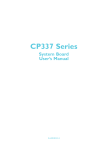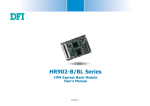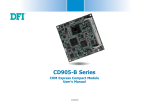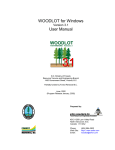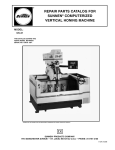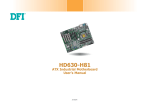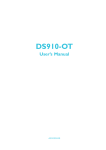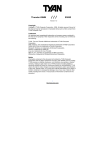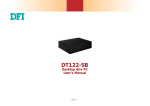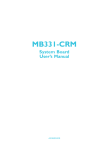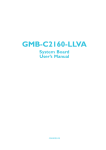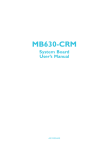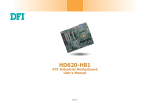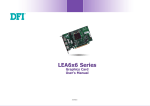Download Manual
Transcript
COM330-B System Board User’s Manual A21110401 Copyright This publication contains information that is protected by copyright. No part of it may be reproduced in any form or by any means or used to make any transformation/adaptation without the prior written permission from the copyright holders. This publication is provided for informational purposes only. The manufacturer makes no representations or warranties with respect to the contents or use of this manual and specifically disclaims any express or implied warranties of merchantability or fitness for any particular purpose. The user will assume the entire risk of the use or the results of the use of this document. Further, the manufacturer reserves the right to revise this publication and make changes to its contents at any time, without obligation to notify any person or entity of such revisions or changes. Changes after the publication’s first release will be based on the product’s revision. The website will always provide the most updated information. © 2014. All Rights Reserved. Trademarks All trademarks and registered trademarks of products appearing in this manual are the properties of their respective holders. FCC and DOC Statement on Class B This equipment has been tested and found to comply with the limits for a Class B digital device, pursuant to Part 15 of the FCC rules. These limits are designed to provide reasonable protection against harmful interference when the equipment is operated in a residential installation. This equipment generates, uses and can radiate radio frequency energy and, if not installed and used in accordance with the instruction manual, may cause harmful interference to radio communications. However, there is no guarantee that interference will not occur in a particular installation. If this equipment does cause harmful interference to radio or television reception, which can be determined by turning the equipment off and on, the user is encouraged to try to correct the interference by one or more of the following measures: • • • • Reorient or relocate the receiving antenna. Increase the separation between the equipment and the receiver. Connect the equipment into an outlet on a circuit different from that to which the receiver is connected. Consult the dealer or an experienced radio TV technician for help. Notice: 1. The changes or modifications not expressly approved by the party responsible for compliance could void the user’s authority to operate the equipment. 2. Shielded interface cables must be used in order to comply with the emission limits. Table of Contents Copyright ........................................................................................... 2 Trademarks ........................................................................................ 2 FCC and DOC Statement on Class B .............................................. 3 About this Manual ............................................................................. 6 Warranty .......................................................................................... 6 Static Electricity Precautions ............................................................. 7 Safety Measures ................................................................................. 7 About the Package ............................................................................ 8 Before Using the System Board ........................................................ 8 Chapter 1 - Introduction .................................................................. 9 Specifications .................................................................................. 9 Chapter 2 - Hardware Installation .................................................. 11 System Board Layout .................................................................... 11 Jumper Settings............................................................................. 12 PS/2 Power Select .................................................................... 12 USB Power Select..................................................................... 13 Panel Power Select ................................................................... 14 CF Card Power Select ............................................................... 15 Backlight Power Select .............................................................. 16 Clear CMOS ............................................................................. 17 Super IO Enable/ Disable .......................................................... 18 VCC5_In Power Select .............................................................. 19 PCIe x16 Normal/ Reversed....................................................... 20 BIOS Select ............................................................................. 21 FWH Write Protect .................................................................... 22 Function Test Jumper ..................................................................... 23 Battery Low Test ...................................................................... 23 Wake-up Test........................................................................... 24 Thermal Trigger ....................................................................... 25 Rear Panel I/O Ports ..................................................................... 26 PS/2 Ports .............................................................................. 27 Serial (COM) Ports ................................................................... 28 VGA Port ................................................................................. 29 RJ45 LAN Port ......................................................................... 30 Universal Serial Bus Connectors ................................................. 31 Audio ...................................................................................... 33 Internal I/O Connectors ................................................................ 34 S/PDIF Connector..................................................................... 34 LVDS LCD Panel Connector and LCD/Inverter Power Connector...... 35 Digital I/O Connector .............................................................. 37 LPC Connector ......................................................................... 38 SATA (Serial ATA) Connectors .................................................... 39 Cooling Fan Connectors............................................................. 40 I2C Connector .......................................................................... 41 SM Bus ................................................................................... 42 Power Connectors .................................................................... 43 Standby Power LED .................................................................. 44 Front Panel Connectors ............................................................. 45 Expansion Slots ....................................................................... 46 Switches ................................................................................. 47 CompactFlash Socket ................................................................ 48 Chassis Instrusion Connector ..................................................... 49 Battery ................................................................................... 50 COM Express Connectors .......................................................... 51 Chapter 3 - Supported Software .................................................... 55 1 Introduction About this Manual An electronic file of this manual is included in the CD. To view the user’s manual in the CD, insert the CD into a CD-ROM drive. The autorun screen (Main Board Utility CD) will appear. Click “User’s Manual” on the main menu. Warranty 6 1. Warranty does not cover damages or failures that arised from misuse of the product, inability to use the product, unauthorized replacement or alteration of components and product specifications. 2. The warranty is void if the product has been subjected to physical abuse, improper installation, modification, accidents or unauthorized repair of the product. 3. Unless otherwise instructed in this user’s manual, the user may not, under any circumstances, attempt to perform service, adjustments or repairs on the product, whether in or out of warranty. It must be returned to the purchase point, factory or authorized service agency for all such work. 4. We will not be liable for any indirect, special, incidental or consequencial damages to the product that has been modified or altered. Introduction 1 Static Electricity Precautions It is quite easy to inadvertently damage your PC, system board, components or devices even before installing them in your system unit. Static electrical discharge can damage computer components without causing any signs of physical damage. You must take extra care in handling them to ensure against electrostatic build-up. 1. To prevent electrostatic build-up, leave the system board in its anti-static bag until you are ready to install it. 2. Wear an antistatic wrist strap. 3. Do all preparation work on a static-free surface. 4. Hold the device only by its edges. Be careful not to touch any of the components, contacts or connections. 5. Avoid touching the pins or contacts on all modules and connectors. Hold modules or connectors by their ends. Important: Electrostatic discharge (ESD) can damage your processor, disk drive and other components. Perform the upgrade instruction procedures described at an ESD workstation only. If such a station is not available, you can provide some ESD protection by wearing an antistatic wrist strap and attaching it to a metal part of the system chassis. If a wrist strap is unavailable, establish and maintain contact with the system chassis throughout any procedures requiring ESD protection. Safety Measures To avoid damage to the system: • Use the correct AC input voltage range. To reduce the risk of electric shock: • Unplug the power cord before removing the system chassis cover for installation or servicing. After installation or servicing, cover the system chassis before plugging the power cord. Battery: • Danger of explosion if battery incorrectly replaced. • Replace only with the same or equivalent type recommend by the manufacturer. • Dispose of used batteries according to local ordinance. 7 1 Introduction About the Package The system board package contains the following items. If any of these items are missing or damaged, please contact your dealer or sales representative for assistance. One Two One One One One One COM330-B board Serial ATA data cables COM port cable (with bracket) USB port cable (with bracket) DVD I/O shield QR (Quick Reference) Optional Items Serial ATA data cable Serial ATA power cable USB port cable COM port cable I/O shield The system board and accessories in the package may not come similar to the information listed above. This may differ in accordance to the sales region or models in which it was sold. For more information about the standard package in your region, please contact your dealer or sales representative. Before Using the System Board Before using the system board, prepare basic system components. If you are installing the system board in a new system, you will need at least the following internal components. • • • A CPU Memory module Storage devices such as hard disk drive, CD-ROM, etc. You will also need external system peripherals you intend to use which will normally include at least a keyboard, a mouse and a video display monitor. 8 Introduction 1 Chapter 1 - Introduction Specifications Audio • Realtek ALC886 5.1-channel High Definition Audio • Audio outputs: Mic-in/Center+Subwoofer, Line-in/Surround and Line-out • S/PDIF audio interface Storage • • Digital I/O • 8-bit Digital I/O connector - 4-bit GPI (General Purpose Input) - 4-bit GPO (General Purpose Output) Rear Panel I/O Ports • • • • • I/O Connectors • • • • • • • • • • • • • • • • 2 1 1 1 1 1 1 4 1 1 1 1 1 1 1 3 Expension Slots • • • • 1 PCIe x16 Gen 3 slot 1 PCIe x4 Gen 2 slot 1 Mini PCIe slot (PCIe 2.0) (PCIe signal only) USB signal: optional Supports half/full size Mini PCIe card 2 PCI slots (PCI 2.3) 4 2 2 1 Serial ATA ports SATA 3.0 ports with data transfer rate up to 6Gb/s SATA 2.0 ports with data transfer rate up to 3Gb/s CompactFlash socket 3 DB-9 RS232 serial ports 1 DB-15 VGA port 1 RJ45 LAN port 4 USB 2.0/1.1 ports Line-in/Surround, Line-out, Mic-in/Center+Subwoofer jacks • 1 mini-DIN-6 PS/2 mouse port (option) • 1 mini-DIN-6 PS/2 keyboard port (option) connectors for 4 external USB 2.0/1.1 ports connector for 1 external RS232 serial port LVDS LCD panel connector LCD/inverter power connector 8-bit Digital I/O connector front audio connector for line-out and mic-in jacks S/PDIF connector Serial ATA ports LPC connector I2C connector SMBus connector 24-pin ATX power connector 4-pin 12V power connector chassis intrusion connector front panel connector fan connectors 9 1 Introduction COM Express Modules • Basic • Compact Damage Free Intelligence • Legacy Super I/O support (option) - Monitors 5V/1.5V/12V/3.3V - Monitors SIO_Fan 1/SIO_Fan 2/SIO_Fan 3 ROM Interface • 1 SPI interface - Supports up to 64Mbit • 1 LPC/FWH interface Temperature • Operating: 0oC to 60oC • Storage: -20oC to 85oC Humidity • 10% to 90% Power Output • 12V, 5VSB, VCC_RTC (ATX mode) 12V, 5V, VCC_RTC (AT mode) 12V, VCC_RTC (AT mode) 10 Certification • CE, FCC Class B, RoHS PCB • • - Dimensions microATX form factor 244mm (9.6”) x 244mm (9.6”) Compliance PICMG COM Express R2.0, Type 2 Hardware Installation 2 Chapter 2 - Hardware Installation System Board Layout Super IO enable/disable (JP3) 1 ATX power LPC 1 2 9 10 PS/2 power select (JP1) PS/2 KB/ MS 1 Fintek F71879 1 Chassis instrusion 1 +12V power 1 BIOS BIOS Select (JP5) 1 (JP6) 1 1 10 9 2 1 Buzzer DIO 2 1 FWH Write protect (J13) Wake-up test (J24) 1 COM2 COM1 12 1 6 19 1 SIO_Fan1 VCC5_IN power select (JP9) 5 PCIe x16 Normal/ Reversed (JP7) Basic Compact CF card power select (JP15) 2 1 COM3 1 CompactFlash Socket Fintek 81217U COM4 VGA LAN USB 2.0 (0-1) Thermal Trigger (J25) USB 0-3 power select (JP2) D1 1 Battery low test 1 USB 2.0 (2-3) (J23) C110 B110 C1 B1 COM express connector 2 I C A110 A1 1 1 Line-in Line-out Mic-in D110 COM express connector 1 1 SATA 1 40 39 SATA 3 1 LVDS LCD panel 2 1 1 SATA 0 SATA 2 8 1 SATA 3.0 SATA 2.0 PCIE x16 LCD/ Inverter power 1 SPI Flash BIOS PCIE x4 Realtek ALC886 2 1 6 1 5 Backlight Power Select(JP12) Panel power select(JP11) Power 5 Reset SM Bus PCI 1 Mini PCIe Front audio 10 9 2 1 S/PDIF PCI 2 1 Clear CMOS (JP10) Front panel Standby Power LED 1 1 10 9 2 1 USB 6-7 Battery USB 4-7 power select 2 (JP4) 1 10 9 USB 4-5 1 SIO_Fan3 11 1 12 2 1 SIO_Fan2 11 2 Hardware Installation Jumper Settings PS/2 Power Select JP1 1 2 3 1-2 On: 5V (default) 1 2 3 2-3 On: 5V_standby 4 1 4 1 5 ON 5 ON JP1 is used to select the power of the PS/2 keyboard/mouse port. Selecting 5V_standby will allow you to use the PS/2 keyboard or PS/2 mouse to wake up the system. Important: The 5VSB power source of your power supply must support ≥720mA. 12 Hardware Installation 2 USB Power Select USB 0-3 (JP2) 4 1 4 1 5 ON 5 ON 1 2 3 1 2 3 1-2 On: 5V (default) 2-3 On: 5V_standby USB 4-7 (JP4) JP2 (for USB 0-3) and JP4 (for USB 4-7) are used to select the power of the USB ports. Selecting 5V_standby will allow you to use a USB keyboard to wake up the system. Important: If you are using the Wake-On-USB Keyboard/Mouse function for 2 USB ports, the 5V_standby power source of your power supply must support ≥1.5A. For 3 or more USB ports, the 5V_standby power source of your power supply must support ≥2A. 13 2 Hardware Installation Panel Power Select JP11 4 1 4 1 5 ON 5 ON 2 4 6 2 4 6 2 4 6 1 3 5 1 3 5 1 3 5 1-2 On: 12V 3-4 On: 5V 5-6 On: 3V (default) JP11 is used to select the power supplied to the LCD panel. Important: Before powering-on the system, make sure JP11’s setting matches the LCD panel’s specification. Selecting the incorrect voltage will seriously damage the LCD panel. 14 Hardware Installation 2 CF Card Power Select JP15 1 1 2 2 3 3 1-2 On: 5V 4 1 4 1 5 ON 5 ON 2-3 On: 3.3V (default) JP15 is used to select the power supplied to the CF card that is on the motherboard. Selecting 3V3 will be the default setting. 15 2 Hardware Installation Backlight Power Select 1 2 3 1-2 On: +5V JP12 4 1 4 1 5 ON 5 ON 1 2 3 2-3 On: +3.3V (default) JP12 is used to select the backlight control level +5V or +3.3V. Important: Before powering-on the system, make sure JP12’s setting matches the backlight power’s specification. Selecting the incorrect voltage will seriously damage the backlight. 16 Hardware Installation 2 Clear CMOS 1 2 3 1-2 On: Normal (default) 4 1 4 1 5 ON 5 ON 1 2 3 JP10 2-3 On: Clear CMOS If you encounter the following, a) CMOS data becomes corrupted. b) You forgot the supervisor or user password. you can reconfigure the system with the default values stored in the ROM BIOS. To load the default values stored in the ROM BIOS, please follow the steps below. 1. Power-off the system and unplug the power cord. 2. Set JP10 pins 2 and 3 to On. Wait for a few seconds and set JP10 back to its default setting, pins 1 and 2 On. 3. Now plug the power cord and power-on the system. 17 2 Hardware Installation Super IO Enable/ Disable JP3 1 2 3 3 1-2 On: Enable 4 1 4 1 5 ON 5 ON JP3 is used to select enable or disable the super IO select. 18 1 2 2-3 On: Disable (default) Hardware Installation 2 VCC5_IN Power Select JP9 2 4 6 1 3 5 1-2 On: 5VSB (default) 4 1 4 1 5 ON 5 ON 2 4 6 1 3 5 3-4 On: 5V 2 4 6 1 3 5 5-6 On: NC JP9 is used to select the power of the COM Express connector. 19 2 Hardware Installation PCIe x16 Normal/ Reversed 1 JP7 2 1-2 On: Normal (default) 1 4 1 4 1 5 ON 5 ON 3 2 3 2-3 On: Reversed (for cards that support reversed signals) IF you are installing a PCIe x16 card who’s signal is reversed, set JP7 pins 2 and 3 to on. 20 Hardware Installation 2 BIOS Select JP5: 1-2 On JP6: 1-2 On 3 3 2 2 1 1 Module SPI BIOS JP5: 2-3 On JP6: 1-2 On 3 3 4 1 4 1 5 ON 5 ON 2 2 1 1 Carrier LPC FWH JP5: 1-2 On JP6: 2-3 On 3 3 2 2 1 1 Carrier SPI0 JP5: 2-3 On JP6: 2-3 On 3 3 2 2 1 1 Module SPI0 (Default) JP5 and JP6 are used to determine the BIOS boot device. 21 2 Hardware Installation FWH Write Protect 2 2 1 1 J13 1-2 On: Enable 4 1 4 1 5 ON 5 ON 1-2 Off: Disable (Default) J13 is used to configure the BIOS Write Protect function. When this function is enabled, the system will be protected from unnecessary updating or flashing of the BIOS. It secures the BIOS therefore any updates to it will not take effect. 22 Hardware Installation 2 Function Test Jumpers Battery Low Test 1 2 1-2 On: Battery low test J23 1 4 1 4 1 5 ON 5 ON 2 1-2 Off: Normal (default) This jumper is used to simulate the signal status that indicates the external battery is low. By setting J23 pins 1 and 2 to On, it sends a battery low signal to the module. 23 2 Hardware Installation Wake-up Test 1 J24 2 1-2 On: Wake-up test 1 2 1-2 Off: Normal (default) 4 1 4 1 5 ON 5 ON This jumper is used to simulate the signal status that indicates the wake-on-ring or PME# event from the Super I/O. It is also used to simulate a general purpose wake-up signal such as wake-up on PS/2 keyboard or PS/2 mouse. Set J24 pins 1 and 2 to On to send WAKE# signal to the module. 24 Hardware Installation 2 Thermal Trigger 1 J25 1-2 On: Thermal Trigger 1 4 1 4 1 5 ON 5 ON 2 2 1-2 Off: Normal (default) This jumper is used to simulate the signal status that indicates the Over Temperature Signal (OVT) output from the Super I/O F71879. When monitored temperature exceeds the OVT value, OVT# will be asserted until the temperature goes below the hysteresis temperature. Set J25 pins 1 and 2 to On to send THRM# signal to the module. 25 2 Hardware Installation Rear Panel I/O Ports PS/2 MS (option) COM 2 COM 4 LAN Line-in Line-out Mic-in PS/2 KB (option) COM 1 VGA USB 0-1 The rear panel I/O ports consist of the following: • • • • • • • • • 26 PS/2 keyboard port PS/2 mouse port 3 COM ports VGA port LAN port 4 USB ports Mic-in jack Line-in jack Line-out jack USB 2-3 Hardware Installation 2 PS/2 Mouse and Keyboard Port PS/2 Mouse and keyboard (option) 4 1 4 1 5 ON 5 ON These ports are used to connect a PS/2 mouse and a PS/2 keyboard. The PS/2 mouse port uses IRQ12. Wake-On-PS/2 Keyboard/Mouse The Wake-On-PS/2 Keyboard/Mouse function allows you to use the PS/2 keyboard or PS/2 mouse to power-on the system. To use this function: • Jumper Setting JP1 must be set to “2-3 On: +5V_standby”. Refer to “PS/2 Power Select” in this chapter for more information. • BIOS Setting Configure the PS/2 keyboard/mouse wake up function in the Advanced menu (“ACPI Power Management Configuration” submenu) of the BIOS. Refer to chapter 3 for more information. Important: The +5V_standby power source of your power supply must support ≥720mA. 27 2 Hardware Installation Serial (COM) Ports COM 2 COM 1 9 RIRTSGND TD DCD- CTSDSRDTRRD COM 3 2 1 COM 4 4 1 4 1 5 ON 5 ON The system board is equipped with 3 onboard serial port (COM 1, COM2 and COM 4). It is also equipped with a 9-pin connector for connecting an external serial port (COM 3). The serial ports are RS-232 asynchronous communication ports with 16C550Acompatible UARTs that can be used with modems, serial printers, remote display terminals, and other serial devices. To connect COM 3, please refer to the following description. The serial port may be mounted on a card-edge bracket. Install the card-edge bracket to an available slot at the rear of the system chassis then insert the cable connector to the 9-pin connector. Make sure the colored stripe on the ribbon cable is aligned with pin 1 of the connector. 28 Hardware Installation 2 VGA Port VGA 4 1 4 1 5 ON 5 ON The VGA port is used for connecting a VGA monitor. Connect the monitor’s 15-pin D-shell cable connector to the VGA port. After you plug the monitor’s cable connector into the VGA port, gently tighten the cable screws to hold the connector in place. 29 2 Hardware Installation RJ45 LAN Port LAN 4 1 4 1 5 ON 5 ON The onboard RJ45 LAN port allows the system board to connect to a local area network by means of a network hub. 30 Hardware Installation 2 Universal Serial Bus Connectors USB 2-3 4 1 4 1 5 ON 5 ON +Data GND N. C. VCC -Data USB 0-1 10 2 1 VCC -Data +Data GND Key 9 USB 6-7 USB 4-5 USB allows data exchange between your computer and a wide range of simultaneously accessible external Plug and Play peripherals. The system board is equipped with four onboard USB 2.0/1.1 ports (USB 0-3). The two 10-pin connectors allow you to connect 4 additional USB 2.0/1.1 ports (USB 4-7). The additional USB ports may be mounted on a card-edge bracket. Install the card-edge bracket to an available slot at the rear of the system chassis and then insert the USB port cables to a connector. BIOS Setting Configure the onboard USB in the Advanced menu (“USB Configuration” submenu) of the BIOS. Refer to chapter 3 for more information. Driver Installation You may need to install the proper drivers in your operating system to use the USB device. Refer to your operating system’s manual or documentation for more information. 31 2 Hardware Installation Wake-On-USB Keyboard/Mouse The Wake-On-USB Keyboard/Mouse function allows you to use a USB keyboard or USB mouse to wake up a system from the S3 (STR - Suspend To RAM) state. To use this function: • Jumper Setting JP2, and/or JP4 must be set to “2-3 On: 5V_standby”. Refer to “USB Power Select” in this chapter for more information. Important: If you are using the Wake-On-USB Keyboard/Mouse function for 2 USB ports, the 5V_standby power source of your power supply must support ≥1.5A. For 3 or more USB ports, the 5V_standby power source of your power supply must support ≥2A. 32 Hardware Installation 2 Audio Line-in Line-out Rear audio Mic-in Front audio 4 1 4 1 5 ON 5 ON Line2-JD key Mic2-JD N.C. GND 10 9 2 1 Line2-L Mic2-R GND Line2-R Mic2-L Rear Audio The system board is equipped with 3 audio jacks. A jack is a one-hole connecting interface for inserting a plug. • Line-in Jack (Light Blue) This jack is used to connect any audio devices such as Hi-fi set, CD player, tape player, AM/FM radio tuner, synthesizer, etc. • Line-out Jack (Lime) This jack is used to connect a headphone or external speakers. • Mic-in Jack (Pink) This jack is used to connect an external microphone. Front Audio The front audio connector allows you to connect to the second line-out and micin jacks that are at the front panel of your system. BIOS Setting Refer to the module’s BIOS for more information. Driver Installation Install the audio driver. Refer to chapter 3 for more information. 33 2 Hardware Installation I/O Connectors S/PDIF Connector 5 1 +5V Key 4 1 4 1 5 ON 5 ON SPDIF in Ground SPDIF out The S/PDIF connector is used to connect external S/PDIF ports. Your S/PDIF ports may be mounted on a card-edge bracket. Install the card-edge bracket to an available slot at the rear of the system chassis then connect the audio cable to the S/PDIF connector. Make sure pin 1 of the audio cable is aligned with pin 1 of the connector. 34 Hardware Installation 2 LVDS LCD Panel Connector LCD/Inverter Power Connector LVDS LCD panel 4 1 4 1 5 ON 5 ON 40 2 39 1 LCD/Inverter power 1 8 The system board allows you to connect a LCD Display Panel by means of the LVDS LCD panel connector and the LCD/Inverter power connector. These connectors transmit video signals and power from the system board to the LCD Display Panel. Refer to the next page for the pin functions of these connectors. Jumper Settings Refer to the “Jumper Settings” section in this chapter for settings relevant to the LCD panel. 35 2 Hardware Installation LVDS LCD Panel Connector Pins Function Pins 1 GND 2 GND 3 LVDS_Out3+ 4 LVDS_Out7+ 5 LVDS_Out3- 6 LVDS_Out7- 7 GND 8 GND 9 LVDS_Out2+ 10 LVDS_Out6+ 11 LVDS_Out2- 12 LVDS_Out6- 13 GND 14 GND 15 LVDS_Out1+ 16 LVDS_Out5+ 17 LVDS_Out1- 18 LVDS_Out5- 19 GND 20 GND 21 LVDS_Out0+ 22 LVDS_Out4+ 23 LVDS_Out0- 24 LVDS_Out4- 25 GND 26 GND 27 LVDS_CLK1+ 28 LVDS_CLK2+ 29 LVDS_CLK1- 30 LVDS_CLK2- 31 GND 32 GND 33 LVDS_DDCCLK 34 N. C. 35 LVDS_DDCDATA 36 N. C. 37 Panel Power 38 Panel Power 39 Panel Power 40 Panel Power Function LCD/Inverter Power Connector Pins Function 36 1 GND 2 GND 3 Panel Inverter Brightness Voltage Control 4 Panel Power 5 +3.3V 6 Panel Backlight On/Off Control 7 +12V 8 +12V Hardware Installation 2 Digital I/O Connector 2 1 19 DIO 4 1 4 1 5 ON 5 ON The 8-bit Digital I/O connector provides powering-on function to external devices that are connected to these connectors. Pin Pin Assignment Pin 1 GND 2 Pin Assignment +12V 3 DIO7(GPO3) 4 +12V 5 DIO6(GPO2) 6 GND 7 DIO5(GPO1) 8 +5V 9 DIO4(GPO0) 10 +5V 11 DIO3(GPI3) 12 GND 13 DIO2(GPI2) 14 5VSB 15 DIO1(GPI1) 16 5VSB 17 DIO0(GPI0) 18 GND 19 GND 37 2 Hardware Installation LPC connector RST# FRAME# LAD3 CLK LAD2 9 1 2 GND VCC3 LAD1 LAD0 4 1 4 1 5 ON 5 ON The Low Pin Count Interface was defined by Intel® Corporation to facilitate the industry’s transition towards legacy free systems. It allows the integration of lowbandwidth legacy I/O components within the system, which are typically provided by a Super I/O controller. Furthermore, it can be used to interface firmware hubs, Trusted Platform Module (TPM) devices and embedded controller solutions. Data transfer on the LPC bus is implemented over a 4 bit serialized data interface, which uses a 33MHz LPC bus clock. For more information about LPC bus refer to the Intel® Low Pin Count Interface Specification Revision 1.1’. 38 Hardware Installation 2 SATA (Serial ATA) Connectors 1 GND RXP RXN GND TXN TXP GND 7 SATA 2.0 3Gb/s SATA 3.0 6Gb/s 4 1 4 1 5 ON 5 ON SATA 1 SATA 3 SATA 0 SATA 2 Features • SATA 0 and SATA 1 support data transfer rate up to 6Gb/s • SATA 2 to SATA 3 support data transfer rate up to 3Gb/s • Integrated Advanced Host Controller Interface (AHCI) controller • Supports RAID 0, RAID 1, RAID 5 and RAID 10 The Serial ATA connectors are used to connect Serial ATA devices. Connect one end of the Serial ATA cable to a SATA connector and the other end to your Serial ATA device. BIOS Setting Refer to the module’s BIOS for more information. 39 2 Hardware Installation Cooling Fan Connectors 1 Ground Power Sense 3 SIO_Fan 1 4 1 4 1 5 ON 5 ON SIO_Fan 2 1 Sense Ground Power SIO fan_3 3 3 1 Sense Ground Power The fan connectors are used to connect cooling fans. The cooling fans will provide adequate airflow throughout the chassis to prevent overheating the module and system board components. 40 Hardware Installation 2 I2C Connector Ground I2C_CLK I2C_DAT 3V3 4 1 4 1 5 ON 5 ON 4 3 2 1 The 1-channel I2C bus interface conforms to the version 2.1 I2C bus specification. It operates as a master or slave device and supports a multi-master bus. 41 2 Hardware Installation SM bus CLK 3VDU SM Bus 4 1 4 1 5 ON 5 ON GND 1 5 Data ALERT- The SMBus (System Management Bus) connector is used to connect SMBus devices. It is a multiple device bus that allows multiple chips to connect to the same bus and enable each one to act as a master by initiating data transfer. 42 Hardware Installation 2 +3.3VDC +12VDC +5VSB +12VDC PWR_OK Ground Ground +5VDC +5VDC +3.3VDC Ground +3.3VDC Power Connectors +5VDC Ground +5VDC NC +5VDC Ground Ground Ground PS_ON# Ground 24 -12VDC 12 +3.3VDC 1 13 Ground Ground 2 1 4 3 +12V +12V 4 1 4 1 5 ON 5 ON Use a power supply that complies with the ATX12V Power Supply Design Guide Version 1.1. An ATX12V power supply unit has a standard 24-pin ATX main power connector that must be inserted into the 24-pin connector. The 4-pin +12V power connector enables the delivery of more +12VDC current to the COM express module board and carrier board’s PCI/ PCIe device. The power connectors from the power supply unit are designed to fit the 24-pin and 4-pin connectors in only one orientation. Make sure to find the proper orientation before plugging the connectors. Important The system board consumes a minimal amount of power. Due to its low power consumption, you only need a 120W to 150W power supply. Every power supply has its minimum load of power. If you use a greater than 150W power supply, the power consumed by the system board may not attain its minimum load causing instability to the entire system. 43 2 Hardware Installation Standby Power LED 4 1 4 1 5 ON 5 ON Standby Power LED This LED will lit red when the system is in the standby mode. It indicates that there is power on the system board. Power-off the PC then unplug the power cord prior to installing any devices. Failure to do so will cause severe damage to the motherboard and components. 44 Hardware Installation 2 Front Panel Connectors HDD-LED RESET-SW 4 1 4 1 5 ON 5 ON 11 12 1 2 PWR-LED HDD-LED - HDD LED PWR-BTN This LED will light when the hard drive is being accessed. RESET SW - Reset Switch This switch allows you to reboot without having to power off the system. PWR-BTN - Power Switch This switch is used to power on or off the system. PWR-LED - Power/Standby LED When the system’s power is on, this LED will light. When the system is in the S0 ,S1 (POS - Power On Suspend), S3 (STR - Suspend To RAM) state, it will be always light. When the system is in the S4 (STD - Suspend to Disc), S5 state, it will be light off. Pin Pin Assignment N. C. 1 N. C. PWR-LED 2 4 6 HDD-LED 3 5 HDD Power Signal PWR-BTN 8 10 Signal Ground RESET SW 7 9 Ground RST Signal 11 N. C. Key 12 Key N. C. Pin Pin Assignment LED Power LED Power Signal 45 2 Hardware Installation Expansion Slots PCI Express x16 PCI Express x4 PCI 1 PCI 2 4 1 4 1 5 ON 5 ON Mini PCI Express (PCIe signal only) PCI Express x16 Slot Install PCI Express x16 graphics card, that comply to the PCI Express specifications, into the PCI Express x16 slot. To install a graphics card into the x16 slot, align the graphics card above the slot then press it down firmly until it is completely seated in the slot. The retaining clip of the slot will automatically hold the graphics card in place. PCI Express x4 Slots Install PCI Express cards such as network cards or other cards that comply to the PCI Express specifications into the PCI Express x4 slot. PCI Slots The PCI slots support expansion cards that comply with PCI specifications. Mini PCIe Slot The Mini PCIe socket is used to install a Mini PCIe card. Mini PCIe card is a small form factor PCI card with the same signal protocol, electrical definitions, and configuration definitions as the conventional PCI. The Mini PCIe slot supports PCIe signal only. To support both PCIe and USB signals, another version will be provided upon request. Since the USB signal for this slot is shared with USB 6, the said version will not support the USB 6 connector. 46 Hardware Installation 2 Switches Power Reset 4 1 4 1 5 ON 5 ON 47 2 Hardware Installation CompactFlash Socket CompactFlash Socket 4 1 4 1 5 ON 5 ON The CompactFlashTM socket is used for inserting a CompactFlashTM card. CompactFlashTM card is a small removable mass storage device designed with flash technology - a non-volatile storage solution that does not require a battery to retain data indefinitely. The CompactFlashTM technology is widely used in products such as portable and desktop computers, digital cameras, handheld data collection scanners, PDAs, Pocket PCs, handy terminals and personal communicators. 48 Hardware Installation 2 Chassis Intrusion Connector 1 Chassis signal 2 Ground 4 1 4 1 5 ON 5 ON The board supports the chassis intrusion detection function. Connect the chassis intrusion sensor cable from the chassis to this connector. When the system’s power is on and a chassis intrusion occurred, an alarm will sound. When the system’s power is off and a chassis intrusion occurred, the alarm will sound only when the system restarts. 49 2 Hardware Installation Battery 4 1 4 1 5 ON 5 ON Battery The lithium ion battery powers the real-time clock and CMOS memory. It is an auxiliary source of power when the main power is shut off. Safety Measures 50 • Danger of explosion if battery incorrectly replaced. • Replace only with the same or equivalent type recommend by the manufacturer. • Dispose of used batteries according to local ordinance. Hardware Installation 2 COM Express Connectors COM Express Connectors (Type 2) 4 1 4 1 5 ON 5 ON The COM Express connectors are used to interface the carrier board with a COM Express board. Refer to the following pages for the pin functions of these connectors. 51 2 52 Hardware Installation Hardware Installation 2 53 2 54 Hardware Installation Supported Software 3 Chapter 3 - Supported Software The CD that came with the system board contains drivers, utilities and software applications required to enhance the performance of the system board. Insert the CD into a CD-ROM drive. The autorun screen (Mainboard Utility CD) will appear. If after inserting the CD, “Autorun” did not automatically start (which is, the Mainboard Utility CD screen did not appear), please go directly to the root directory of the CD and double-click “Setup”. 55 3 Supported Software Audio Drivers To install the driver, click “Audio Drivers” on the main menu. 1. Setup is now ready to install the audio driver. Click Next. 2. Follow the remainder of the steps on the screen; clicking “Next” each time you finish a step. 3. Click “Yes, I want to restart my computer now” then click Finish. 56 Restarting the system will allow the new software installation to take effect. Supported Software 3 Adobe Acrobat Reader 9.3 To install the reader, click “Adobe Acrobat Reader 9.3” on the main menu. 1. Click Next to install or click Change Destination Folder to select another folder. 2. Click Install to begin installation. 3. Click Finish to exit installation. 57

























































